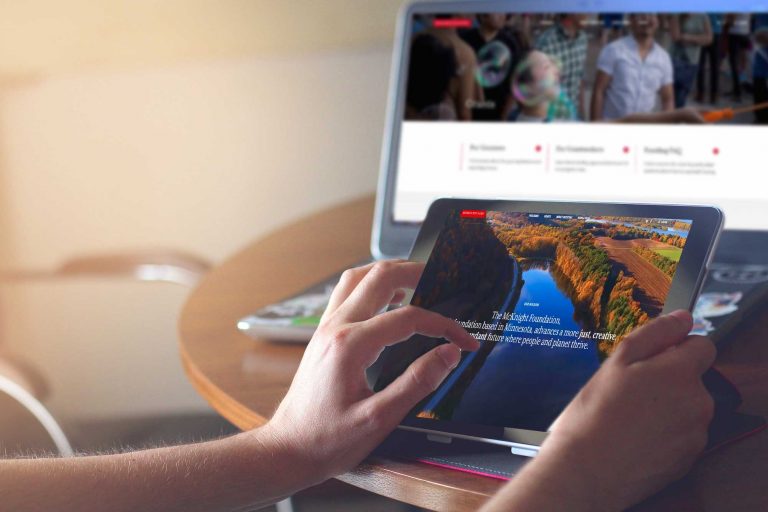Taking a Fresh Approach to a Traditional Assignment
Annual reports are a strange beast in the digital age. They were once a signature form of brand storytelling. In the age of 24/7/365 multi-screen, surround sound digital communication, some foundation communicators question their value.
When it came time to planning McKnight’s annual report, I was mindful of this evolution and yet not ready to abandon the tradition altogether. I decided to test out a different model. This year, McKnight piloted a digital-first annual report that sought to be as useful and mission-oriented as possible.
Below are some best practices embedded in the report. Many of these insights were gleaned from resources such as the Communications Network, Spitfire, Frank, Wonder, Goodwin Simon Strategic Research, the Frameworks Institute, Hatch for Good, the Solutions Journalism Network, and George Lakoff, among others. I’m grateful to these organizations, as well as our creative partner Pollen Midwest.
Best Practices for Public Interest Communicators
Lift up a positive vision of what is possible. Research shows framing an issue constructively inspires hope and action while dwelling on deficits overwhelms readers. Using the theme of Empower, we position individuals and communities as agents of change rather than as victims. As Frameworks puts it, we need to hear more about The Little Engine That Could and less of Chicken Little. Yes, meticulously diagnosing our biggest social problems and sounding the alarms have their place. And we must spend just as much time describing how we can begin to make progress.
Using what’s called asset-based framing, we show people’s strengths and what they are capable of accomplishing despite the barriers. Take the issue of how to combat childhood malnutrition in Africa at scale. The topic cries for sympathy given the millions of children who suffer from preventable diseases related to vitamin A deficiency. We choose, instead, to tell the story of a Ugandan scientist saving lives by infusing vitamin A in a common food staple. Hence, the focus shifts to what’s possible rather than what might seem impossible.
Use simple, clear language. What does “capacity building” or “leveraging resources” or “inclusive economy” really mean? Only a narrow swath of people appreciate these buzzwords. To invite more diverse people into our conversations, we minimize jargon and acronyms whenever possible. While philanthropy communication is often appropriately targeted to sector experts, we must remember that engaging intelligent lay audiences across sectors and walks of life is critical to advancing progress.
Present actionable intelligence. We feature change agents pushing forward innovative solutions so that others might be able to build on the progress. We tell the stories of what social scientists call positive deviants, or examples of people finding ways to forge solutions even when similarly constrained as their peers. We want mayors and regional leaders across the country to hear our evidence of how artists can revitalize small towns. We want corporate sustainability executives to consider a new way to improve their supply chains as research on the perennial grain Kernza® advances.
Be relevant and timely. Our annual report affirms our values at a critical inflection point. For example, we highlight a new generation of innovators emerging out of Greater Minnesota and Appalachia to counter the facile stereotypes of rural communities. Our four decades of funding basic neuroscience research is a testament to how much we value the integrity of science. Our education story points out the rich social and economic contributions of immigrants and refugees, which is all the more reason to better understand our newest neighbors. The report advances our credible influence by simply and concretely showing our values in action.
Humanize complex issues. Personal narratives can illustrate how various theories, policies, and systems touch the real everyday lives of ordinary people. It can be hard to wrap one’s mind around the myriad challenges of a coal-dependent community that needs to transition to a more diversified economy. Spend some time with a lumber entrepreneur bringing dozens of jobs to Renick, West Virginia (pop. 210), and we get a better sense of where to begin. Or, consider the dramatic loss of decent affordable housing in Minneapolis, an urgent but abstract issue. The human cost becomes clearer after a mother explains how she returns home from her factory job to an infestation of bedbugs and a broken furnace in the dead of winter.
Dedicate more time to distributing content. We intentionally budgeted more time and energy on email and social media engagement to target audiences than we have for previous annual reports. Content strategists advise a 40/60 ratio between time spent on content creation versus promotion. It’s a ratio most of us find daunting. The only way to accomplish anything close to that is to produce fewer communications products and drop those that are low on the impact scale. Painful as it was, we made some tough decisions early on to shed some of our lower-impact assignments to make room for greater impact elsewhere. My motto: If it doesn’t advance mission, just don’t do it.
What’s Ahead for McKnight Communications
Next year, McKnight will join the growing number of foundations that no longer produce annual reports. The fact is, we need to tell our story and implement communications best practices on all our platforms year-round. To achieve this, we’ve created a new digital engagement officer position, and a revamped website is coming down the pike as well. I’m convinced public interest communicators can accelerate progress on our causes by shedding pro forma releases and reports produced for the sake of tradition. We need to invest our time and energy instead on more purposeful strategies.

